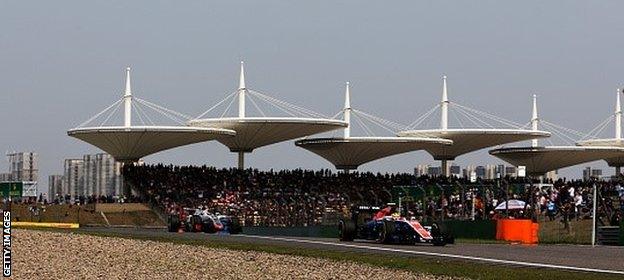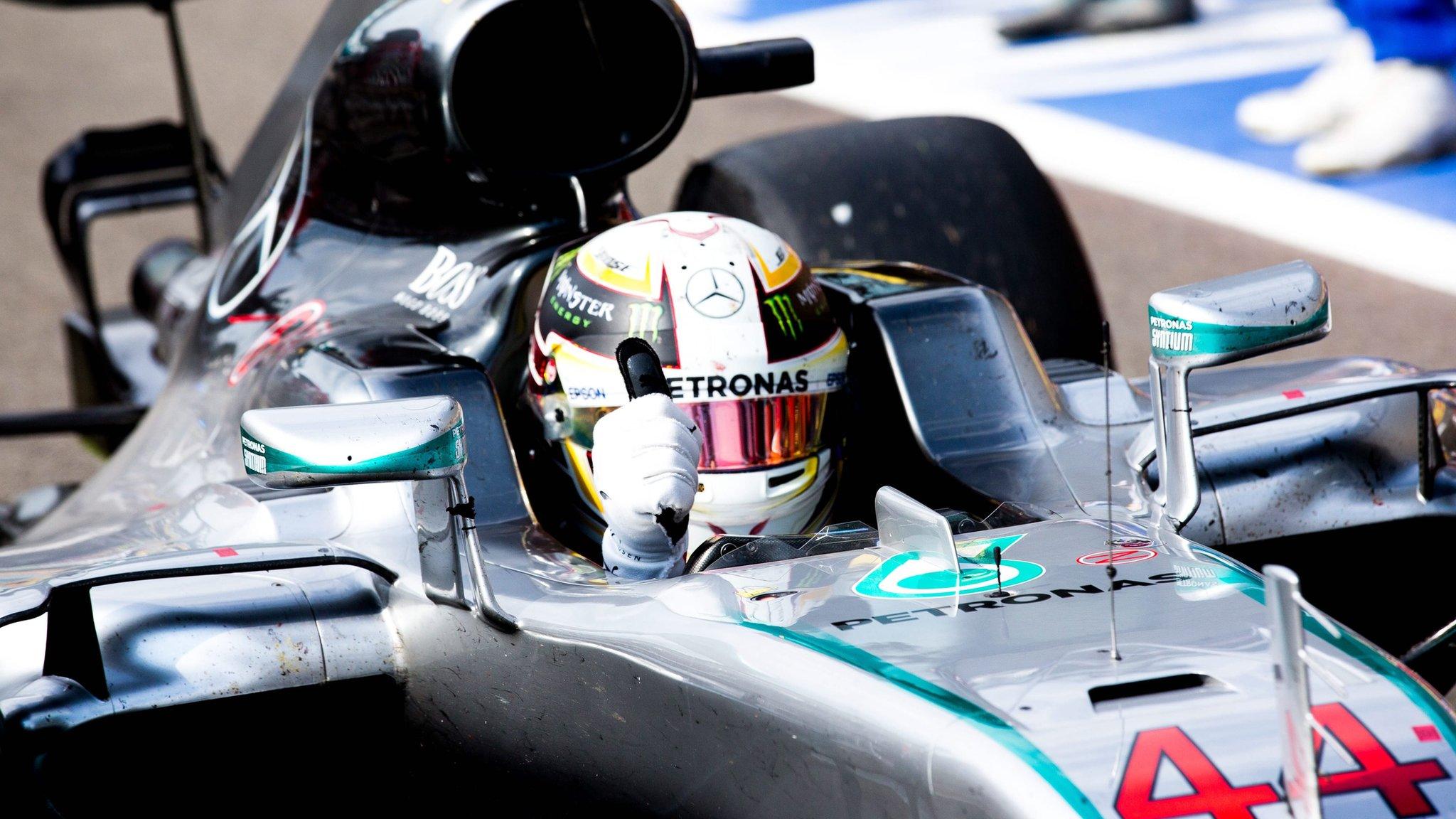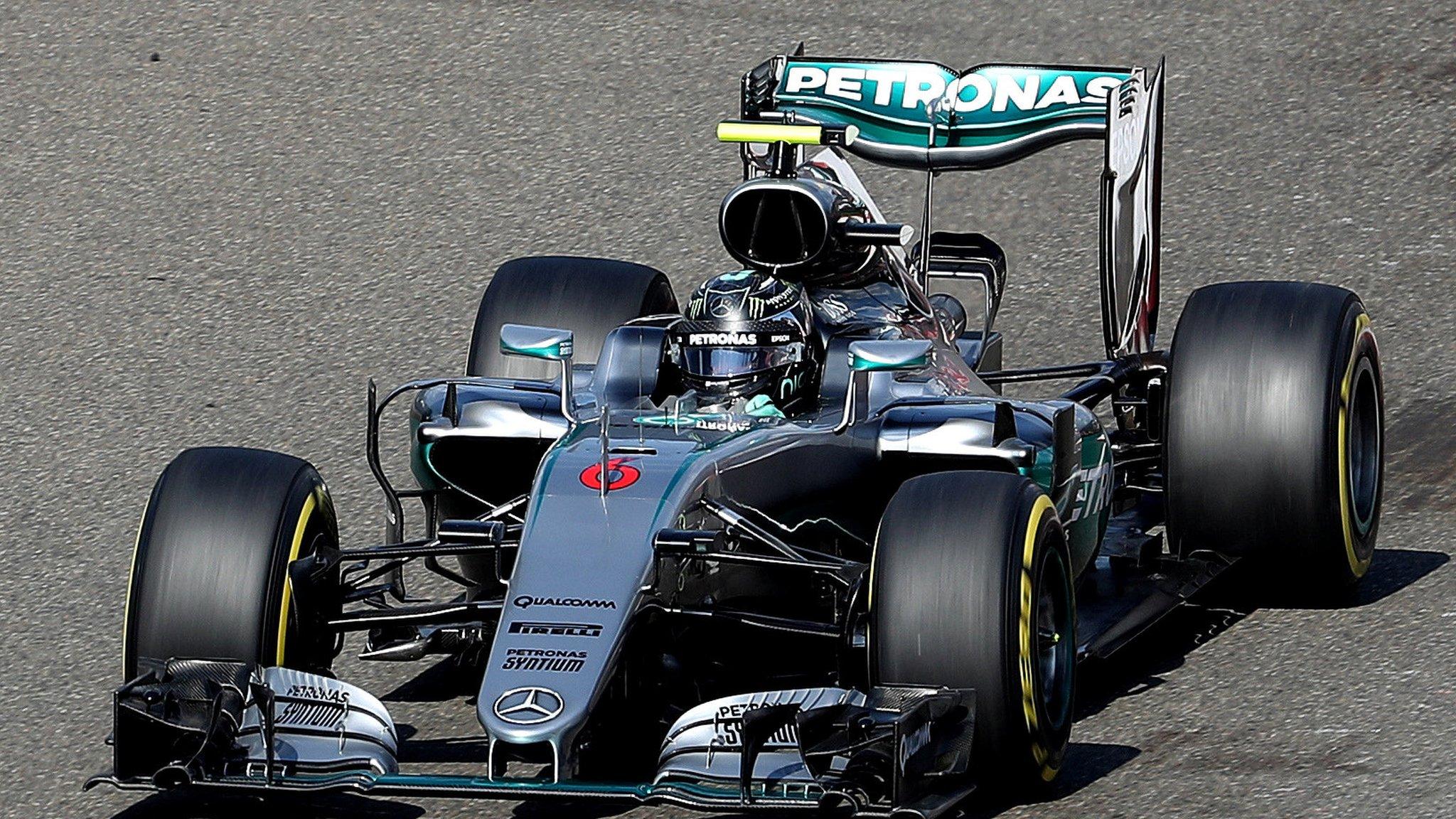F1 to close engine loophole after Lewis Hamilton's Belgian GP penalty
- Published

Lewis Hamilton (44) driving his Mercedes during the Belgian Grand Prix
Formula 1 has closed a loophole that allowed teams to get around rules restricting engine parts without incurring excessive penalties.
It was exploited by Mercedes at this year's Belgian Grand Prix.
Lewis Hamilton started at the back of the grid despite the team fitting three new engines and incurring penalties totalling 55 grid places.
From 2017, the rule has been changed so teams cannot stockpile new parts for subsequent races without penalty.
The move was one of several announced following Wednesday's meeting of the FIA World Council, which also revealed a provisional 2017 calendar that closely echoes this year's record 21-race season.
The season will start in Australia on 26 March and end in Abu Dhabi on 26 November. The British Grand Prix is on 9 July and the Canadian, German and Brazilian races are listed as subject to confirmation.
What's the engine rule?
The new rule on engine parts is the latest attempt by governing body the FIA to find the best possible solution to a set of rules aimed at keeping a lid on costs while also allowing manufacturers to develop their power units so their performance converges.
This year's loophole arose out of criticism of the first version of the rule, introduced when the complex turbo hybrid engines were first used in F1 in 2014.
Then, if the totality of a penalty could not be served by being demoted a number of places on the grid, a series of in-race penalties were imposed.
That was deemed too complicated and overly punitive, so the rule was changed so the worst a driver could suffer was to be put to the back of the grid, no matter how large the academic penalty.
But because teams were abusing this by taking a series of new engines at a single race, the new rule will mean that, in such circumstances, only one of each new part can be penalised at the first race.
If a series of new examples of a specific part is taken, then any beyond one will be penalised at subsequent races.
So, for example, if a driver uses three new internal combustion engines at one race, and is penalised accordingly with grid places, he may only add the last of the three to his race 'pool'.
If either of the first two new units are used again at a subsequent event they would be treated as new ones for the purpose of assessing penalties.
The size of the penalty arises out of the engines rules which stipulate that teams can use each season only five of each of the six elements of the complex turbo hybrid engines that were introduced in 2014.
These elements are the internal combustion engine, the turbocharger, control electronics, energy store (battery) and the MGU-K and MGU-H - the two motors that recover energy from the rear axle and the turbo.
There is a series of grid penalties for using more than the permitted number of these parts - 10 places for the first time a sixth of any of the parts is used and five places for any subsequent sixth element; 10 places for the first time a seventh element is used and five places for each subsequent one, and so on.
But because penalties could not be carried over and because it was decided that no further penalties would be imposed other than going to the back of the grid, teams have tended when they suffer a penalty to take as many engine parts as they feel they need for future races, so as to be penalised only once.
The new rule says: "During any single event, if a driver introduces more than one of a power unit element that is subject to penalty, only the last element fitted may be used at subsequent events without further penalty. This is to prevent the stockpiling of spare power unit elements."
So, if for example a team needs to fit a new MGU-H and it is the driver's sixth of the season, they cannot put into their allocation a seventh MGU-H without also incurring an identical penalty at the next race.
Other rule changes
The World Council rubber-stamped a decision to have a standing restart for a wet race that starts under the safety car.
And it changed the rule on tyre selection for the first five races of next season.
Because of the uncertainty caused by the introduction of new rules that are aimed at speeding up the cars by as much as five seconds a lap, the teams' ability to choose their own selection of three types of tyre has been suspended for the first five races of 2017.
Instead, Pirelli will choose the three types of tyres at each race - two sets of the hardest compound chosen, four of the middle, and seven of the softest.
The new calendar

The Chinese Grand Prix is the second race on the 2017 calendar
The 2017 calendar has very few changes from this year.
The first four races are shuffled, so China follows a week after Australia, replacing Bahrain as the second race.
And Malaysia is moved to 17 September and becomes the first of the long-haul 'fly-away' races that bring the season to a close, a position previously held by Singapore.
The uncertainty over the Canadian, German and Brazilian races is not specified.
Montreal organisers have not yet started promised modernisation works.
Germany is still suffering from the financial collapse of the Nurburgring, which was due to host the race next season in its alternation agreement with Hockenheim, which has been listed as the host track instead.
And Brazil has been reported to be in discussions with F1 boss Bernie Ecclestone about the cost of its deal.
The full provisional calendar is as follows:
26 March Australia
9 April China
16 April Bahrain
30 April Russia
14 May Spain
28 May Monaco
11 June Canada *
18 June Azerbaijan
2 July Austria
9 July Britain
23 July Hungary
30 July Germany *
27 August Belgium
3 September Italy
17 September Malaysia
1 October Singapore
8 October Japan
22 October USA
5 November Mexico City
12 November Brazil*
26 November Abu Dhabi
*Subject to confirmation
- Published28 August 2016

- Published28 August 2016

- Published27 August 2016

- Published27 August 2016

- Published26 August 2016

- Published18 December 2015

- Published8 August 2017

- Published13 May 2016

- Published26 February 2019
